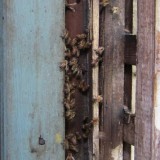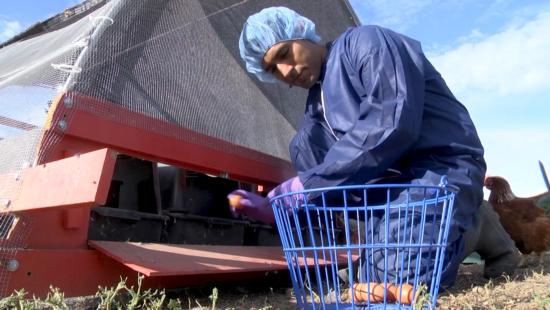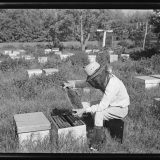
Image: Mark Osgatharp.
In February my phone starts to ring with what I call “bee situations.” With that in mind I’m going to write a series of blog posts to explain some basic bee biology and what services beekeepers can provide when bees show up where they are not wanted. Most of what I describe will be universal, but some information will deal with the peculiarities of honeybees in a Mediterranean climate such as Los Angeles. Speaking of which, peak swarm season begins earlier here than in colder places and swarms can happen anytime of the year including our “winter.”

Image: Wikipedia.
Basic Swarm Biology
Swarms are the way honeybee colonies reproduce. As with all matters related to the biology of the honeybee, it’s easier to think of a colony as a single super-organism rather than thousands of individuals. Swarming takes place when a colony decides to make a new queen. Once the new queen hatches, the old queen takes off with about half the workers. I’m oversimplifying here and leaving out the complexities of drones and queen mating, but thinking again of a colony as a super-organism, bee swarming is akin to a single celled organism that reproduces by dividing in two. I should note that many colonies, especially in Southern California, produce consecutive swarms but the idea of reproduction by division is still the same.
When the old queen and workers leave the original colony they have to find a new permanent home. Their natural preference is for a hollow portion of a tree. But they’ll take any dark enclosure with a small, easily defensible, entrance. In urban areas, in addition to tree cavities, they might choose the walls of buildings, utility boxes, compost bins and even the inner workings of hot tubs. But before a swarm can find permanent digs, they need a place for the swarm to hang out while the swarm’s scouts go off in search of the perfect home.
Where a swarm lands
When shopping for permanent real estate most swarms end up resting on a tree branch. But they can also pick an odd location, like a bike seat, a light pole or even a car bumper. So how can you tell when a bunch of bees are just visiting a spot temporarily? The answer is simple. Swarming bees don’t have any comb. They’re just hanging out in a big ball of workers with the queen in the center. If you don’t see comb, you know this swarm is just temporarily resting in that spot.
So you’ve got one of these big balls of bees on your tree/bike/fence/bumper! What do you do?
The best answer is to do nothing. Bees that have swarmed have no honey to protect and tend to be very docile (I’ll note an exception below). Odds are that they will move on in a few hours or a day or two at most. You don’t need to call anyone or panic.
The poignant thing about a swarm is that they only have a few days to find a home before they die of exposure and hunger. Swarming is a high risk, transitory state. Never fear that a bunch of swarming bees will end up hanging out in your yard permanently. They will move on, or they will die, and the time frame is just a few days.
If you absolutely must do something about it, please contact your local beekeeping association and obtain the services of a genuine beekeeper. Do not Google “beekeeper” as you will likely end up with a con artist (see my post on bee removal scams).
A reputable beekeeper will remove a swarm in one of three ways: by putting nuc box or bee box right next to the swarm and allowing them to move in on their own, by bumping the swarm into a bee box or other suitable container, or by using a bee vac and sucking them up. The beekeeper will then take the bees and install them in a bee box back in their apiary. My favored technique is to spray the swarm with sugar water (this keeps them distracted) and bump them into a portable “nuc” box. Here’s a video of our mentor, beekeeper Kirk Anderson, moving a swarm:
The con artist “beekeepers” will either spray them with poison, suck them into a vacuum and kill them or put them in a box and then just toss them out in a nearby park or vacant lot. And they’ll charge you much more than a real beekeeper would.
Bee temperament when swarming
As I already noted swarms are most often so docile that you can approach them without protective gear. But not always. A swarm that’s been hanging out for a long time without finding a permanent home can get slightly cranky. Note that I said slightly cranky. It’s not like they’re all going to suddenly attack you like a scene from that silly 1970s disaster movie “The Swarm.” More likely a cranky swarm will give you a gentle reminder to keep your distance–a sting or two. This is why I wear a bee suit when doing a swarm capture. But there is no reason to panic when a swarm shows up!
What is not a “swarm”
In an established bee colony, once a day every day, the young bees do what is called an orientation flight. During orientation, hundreds of bees come out and fly around in circles in front of the entrance to the hive. They are learning the location of their home so that when they become foragers, they will know where to return to. Sometimes this behavior is confused with a swarm, but it is not. Orienting bees will not cluster anywhere, and the orientation session only lasts a short while.
So if you see dozens but not thousands of bees flying around in circles, you are also not witnessing a swarm. There is probably a hive nearby and you are witnessing an orientation. Another possibility is that you might also be seeing wasps or hornets, not honeybees. Here’s what wasps look like and what you should do about them (hint: nothing).
Help, the swarm is African and we’re all gonna die!
Calm down. I can’t speak for all the bees in Africanized bee country (the southern part of the U.S., Mexico, Central and South America) but the bees here in Los Angeles that you see swarming are likely Africanized, but they aren’t killers. I will be dealing with the Africanized controversy in another post, but trust me, I’ve never kept European bees and have always kept the local Africanized bees and I’ve not found them to be overly aggressive at least here in Southern California. You can’t tell Africanized bees from European bees without a DNA test and I’ll note that there are plenty of aggressive European colonies too. But please don’t let anyone panic about the swarm on your tree because they are “African.” They don’t know what they’re talking about.
Help, I’ve got a swarm of bees and I’m calling Root Simple!
Here’s what I will and will not do. If a swarm lands in an easily accessible location and I need a hive or I know someone who does I’m happy to come pick them up as long as you are in central Los Angeles. If they are on a high branch, I can’t get them unless you’re an institution that owns a lift and you can get me up there safely. In that case just wait a few days and they’ll take off on their own. If you’re in the LA area and need a reputable beekeeper please contact Honey Love.
Those times the swarm sticks around
Very rarely a swarm that has landed in a tree can’t find a home and decides to start building comb right where they are (here’s what this looks like). This is a warm climate issue. Honeybees in the tropics build colonies like this. In our Mediterranean climate the odds are they won’t survive this strategy as it’s a little too cold here in the winter, and the rain can cause the comb to break and fall to the ground. When you have one of these freak exterior bee colonies you need to call a beekeeper to deal with the situation.
Have you witnessed a swarm? Have you seen a swarm where you work? How did you or your colleagues react?




Very nice post. Thank you for sharing this very important information with us before spring is coming.
I have seen a handful of swarms in the past couple of years and was wondering how crazy/futile it would be to try and entice one to move into a bee box as a way to begin beekeeping. If I build it might they come? I’ve noticed that they tend to stop where there is lots of forage and I have lots of beefriendly plants in my garden. Could it work?
I’m with carlita- I’d like to entice a swarm to start beekeeping. Ideas would be much appreciated!
Not crazy at all. I’ve had swarms move in on their own–the best kind of bees to have as they chose where they wanted to live! According to Michael Bush you have about a one in 10 chance of bees moving into your boxes. Some people say that lemongrass essential oil works as an attractant. You can put some on a cotton ball and put that into a pill bottle with holes cut in it. Or you can buy special bee lure pheromone but it’s expensive and doesn’t work for long.
Awesome article. Admittedly I know nothing about bees so this was really insightful. Looking forward to reading the next one!
Those of you who have expressed an interest in beekeeping need to contact your local beekeeping association to get some training and to find someone who will mentor you. It’s not as simple as just catching a swarm Without proper training and equipment, you can get seriously stung and harm the bees.
Yes, I completely agree! Get a mentor and then make sure that you have a suit, smoker and all the other equipment you’ll need. Another advantage with a beekeeping group is that you’ll have help if you have to move a hive or have questions.
Some of us actually draw those swarms to our own yards, and will gladly drive to peoples homes to capture those swarms free of charge. Please, do not spray them or otherwise destroy them. The honeybee is in peril and should be managed is such a way to reduce all losses.
Bear in mind though, that if a swarm does take residency within the floors or walls of your home, you need to call a professional- and that kind of service is rather expensive & time consuming to properly deal with.